Meet the Presenter
This article is based on a webinar titled High-Efficiency Low-Toxicity Ionic Liquids as Lubricant Additives hosted by the American Society of Mechanical Engineers’ (ASME) Tribology Division and presented by Dr. Jun Qu on Jan. 29, 2024. Courtesy of STLE, this article captures the core insights from this ASME-organized event. For more technical content from the ASME Tribology Division Webinar Series, visit the ASME Tribology Division’s website at www.asme.org/get-involved/groups-sections-and-technical-divisions/technical-divisions/technical-divisions-community-pages/tribology-division.
Jun Qu is a Corporate Fellow and Group Leader of Surface Engineering & Tribology in the Materials Science and Technology Division at Oak Ridge National Laboratory. He has a master of science degree in mechanical engineering from Iowa State University and a doctorate degree in mechanical engineering from North Carolina State University. His research interests include advanced lubrication, surface engineering, materials tribology, nanostructured materials and manufacturing. He has developed two ASTM standards, published three book chapters and more than 140 journal papers and received 11 U.S. patents. Dr. Qu has received multiple national awards including a DOE Vehicle Technologies Office R&D Award and an R&D 100 Award. He is an STLE Fellow, on the STLE Board of Directors, serves on the Board of Directors for the Wear of Materials conferences and is the editor-in-chief for Elsevier’s Encyclopedia of Tribology & Lubrication.
The research presented here was supported by the Vehicle Technologies Office and Water Power Technologies Office of the Office of Energy Efficiency and Renewable Energy of U.S. Department of Energy and the Technology Innovation Program of Oak Ridge National Laboratory. You can reach Dr. Qu at qujn@ornl.gov.

Dr. Jun Qu
KEY CONCEPTS
•
Unlike some other ionic liquids, short-chain organic phosphonium phosphate and ammonium phosphate ionic liquids have low toxicity, promote oil biodegradability and are effective in reducing friction and wear.
• The new ionic liquids outperform conventional lubricant additives in terms of friction and wear reduction and have potentially less environmental impact
•
Ionic liquid additives are getting closer to entering the commercial market for use in demanding applications.
Environmentally acceptable lubricants (EALs)
1 have seen increasing demand in many industrial applications, including hydropower turbomachinery, hydraulic systems, compressors and manufacturing processes. Much of this demand is driven by regulatory requirements, but there is also a growing interest in ecofriendly lubricants for reducing negative effects on human health, wildlife and ecosystems. The global EALs market is expected to have a compound annual growth rate more than triple that of the overall lubricants market in the next decade.
2,3
Conventional lubricants, which are typically mineral oil-based, have low biodegradability and are often toxic. A significant amount of the lubricants sold worldwide is eventually released into the environment through leaks, spills, volatilization and other losses. Leaks and spills from hydropower facilities are difficult to isolate from streams, and they contaminate water resources directly, posing a serious threat to the aquatic ecosystem. Hydraulic fluids are a major source of the tens of millions of liters of lubricating oil lost annually to leaks and operational discharges. These fluids are widely used in industrial machinery, large ships and off-road vehicles. The cost of initial responses alone for fluid leaks and other losses total more than $300 million annually.
4
Ionic liquids present unique opportunities as lubricant additives, and in many cases, they outperform well-established conventional additives. Thus, STLE member Dr. Jun Qu and his colleagues at Oak Ridge National Laboratory (ORNL) are working to develop ionic liquids that not only possess superior tribological functionalities but are ecofriendly to potentially serve as the next generation of EAL additives for a wide variety of applications.
This article is based on a webinar by Qu with ORNL and the Tribology Division of the American Society of Mechanical Engineers (ASME) on high-efficiency low-toxicity ionic liquids as lubricant additives. See Meet the Presenter for more information.
A new solution to an old problem
There are five main types of U.S. Environmental Protection Agency (EPA)-approved base fluids for EALs: water, vegetable oils, synthetic esters, polyalkylene glycols (PAGs) and polyalphaolefins (PAOs). These liquids are beginning to replace mineral oils as base fluids in environmentally sensitive lubricant applications. An EAL-based formulation contains various functional additives that are vital ingredients for meeting performance requirements: antiwear additives and corrosion inhibitors, to cite two examples.
Ionic liquids (ILs), organic salts that are molten at room temperature, are composed of cations and anions rather than neutral molecules. ILs have been primarily used as “green” solvents in chemical synthesis, electrochemistry and other applications because of their ultra-low vapor pressure, nonflammability and high thermal stability.
ILs are also being explored as neat lubricants, lubricant base stocks or lubricant additives. Their advantages include high thermal stability (up to 500°C) and high viscosity index (120-370). Their resistance to viscosity changes under pressure makes them effective in reducing elastohydrodynamic (EHL) friction. In addition, their strong adsorption to surfaces reduces boundary friction, and the strong tribofilms they form offer excellent wear protection. Oil-soluble ILs have been discovered as promising lubricant additives.
5 However, not all ILs are suitable for use in lubricants, and fewer can be included in the EAL family.
Qu and his colleagues at ORNL have invented and patented several groups of oil-miscible ILs for use as lubricant additives
6 (see Figure 1). These liquids are noncorrosive, ashless, thermally stable and superior in reducing friction and wear compared with the commercial baseline. More recently, they developed a new class of ILs that possess low aquatic toxicity and enhance oil biodegradability.
7
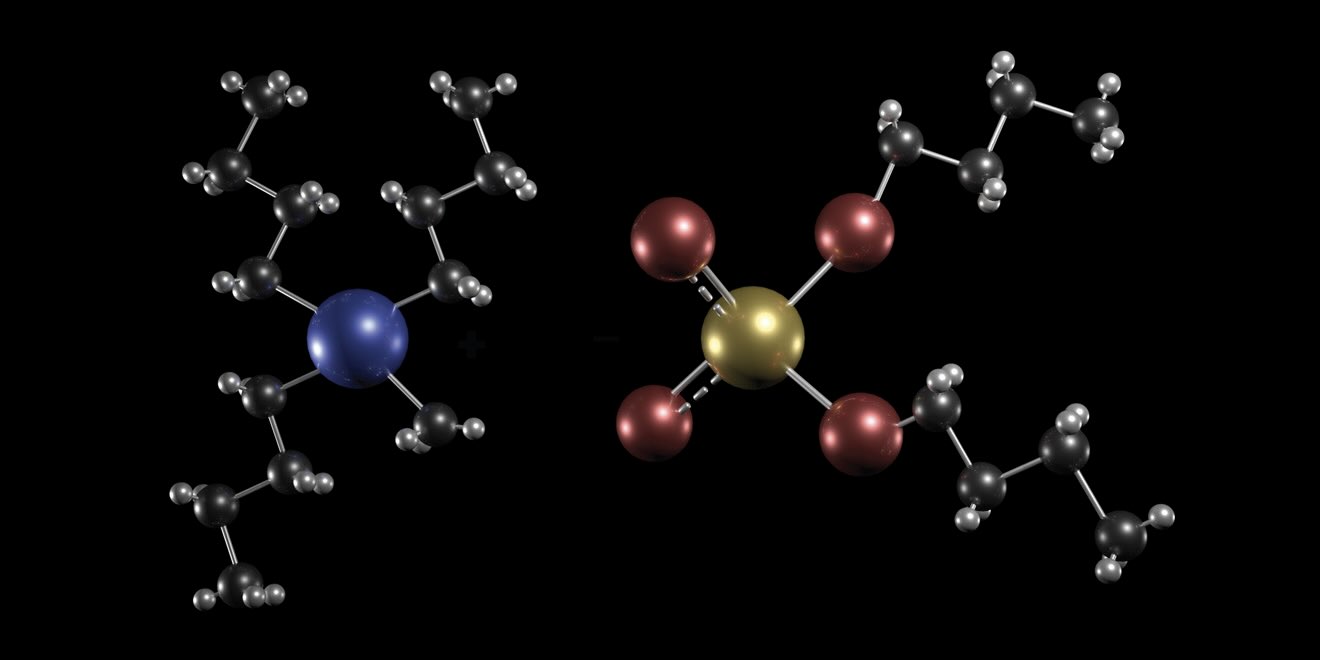 Figure 1. Ionic liquids contain organic cations and anions rather than neutral molecules. Figure courtesy of Jun Qu.
Figure 1. Ionic liquids contain organic cations and anions rather than neutral molecules. Figure courtesy of Jun Qu.
Properties and performance
How do ILs perform in lubrication? IL-generated tribofilms are believed to be responsible for friction reduction and wear protection. Qu and colleagues studied tribofilms for several of their IL compounds. They showed that an IL tribofilm is composed of metal phosphates and metal oxides, and a higher concentration of phosphates promotes reducing friction and wear. But they observed no correlation between tribofilm hardness and amounts of friction and wear.8 Instead, a lower ratio of load to stiffness squared (P/S
2), representing a material’s resistance to plastic deformation, often leads to a better wear protection. This behavior differs from that of bulk materials or coatings, and this difference is attributed to the dynamic, sacrificial, self-healing nature of IL tribofilms.
8
To understand the IL tribofilm formation process, Qu and his group examined IL tribofilms on both ferrous alloy and iron-free surfaces, as well as the wear debris, using high-resolution transmission electron microscopy, X-ray photoelectron spectroscopy and 3D atom probe tomography
(see Figure 2). Based on their observations, they established a wear debris evolution-based tribofilm growth model for ILs
9 (
see Figure 3).
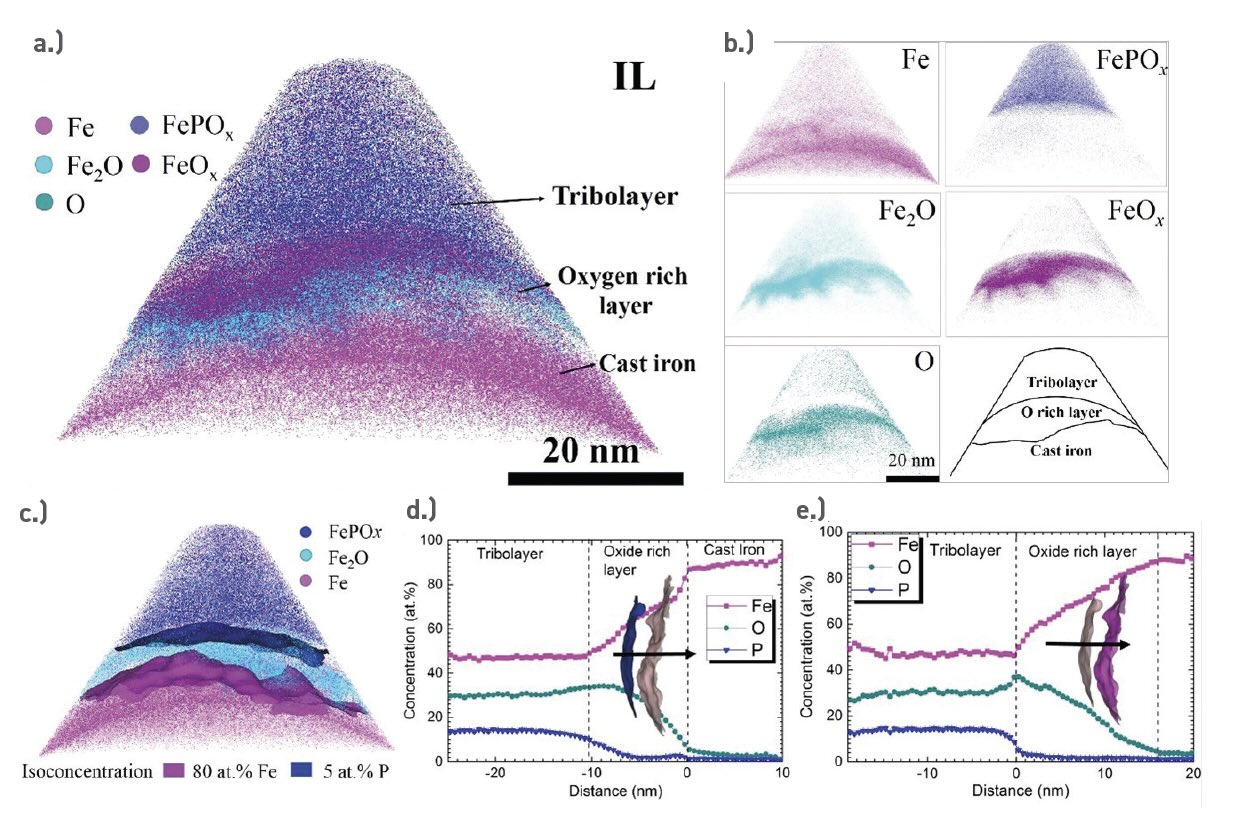 Figure 2. 3D atom probe tomography (APT) reconstruction of the tribofilm produced by an ionic liquid showing a graded-layer structure. Figure courtesy of Guo, W., Zhou, Y., Qu, J., et al. (2017), “Atom probe tomography unveils formation mechanisms of wear-protective tribofilms by ZDDP, ionic liquid, and their combination,” ACS Applied Materials & Interfaces, 9, pp. 23152-23163. Available at https://doi.org/10.1021/acsami.7b04719. Reprinted with permission from Wei Guo, Yan Zhou, Xiahan Sang, et al., Applied Materials. Copyright 2017 American Chemical Society.
Figure 2. 3D atom probe tomography (APT) reconstruction of the tribofilm produced by an ionic liquid showing a graded-layer structure. Figure courtesy of Guo, W., Zhou, Y., Qu, J., et al. (2017), “Atom probe tomography unveils formation mechanisms of wear-protective tribofilms by ZDDP, ionic liquid, and their combination,” ACS Applied Materials & Interfaces, 9, pp. 23152-23163. Available at https://doi.org/10.1021/acsami.7b04719. Reprinted with permission from Wei Guo, Yan Zhou, Xiahan Sang, et al., Applied Materials. Copyright 2017 American Chemical Society.
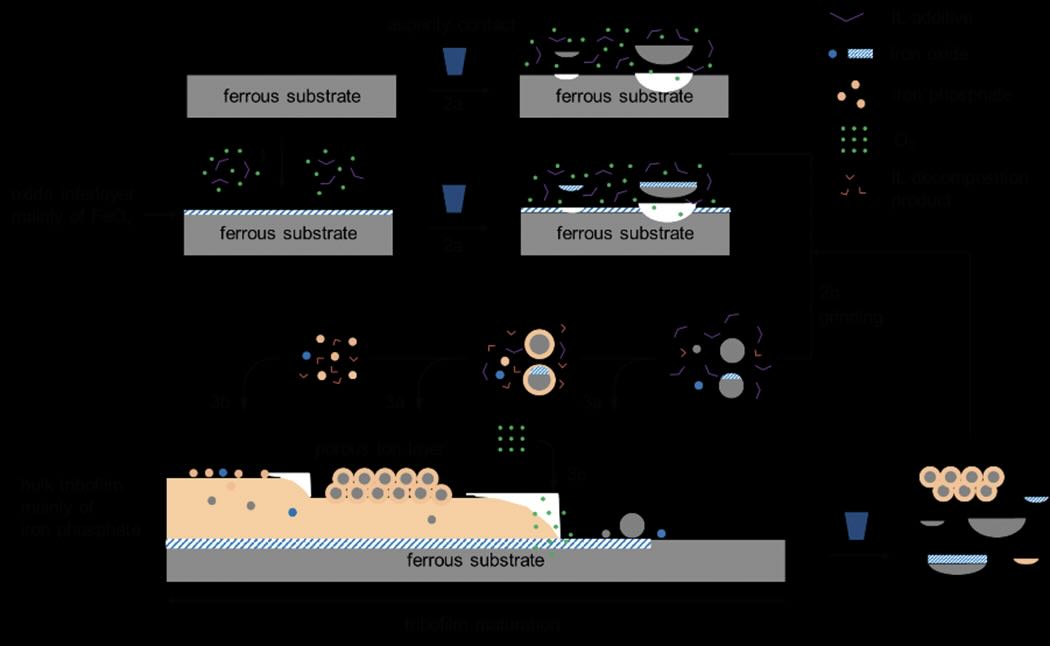
Figure 3. Wear debris evolution-based tribofilm growth model for ionic liquids. Figure courtesy of Ref. 9, CC BY 4.0.
The wear process begins when asperities on two surfaces come into contact. For the example of a ferrous substrate, which may have an oxidized surface layer, the model shows that the interfacial area becomes enriched in iron oxide particles, which mix with IL additives and their decomposition products. Iron and iron oxide particles serve as nuclei for core-shell assemblies with iron phosphate outer layers. A bulk tribofilm, composed mainly of FePO
xforms over the iron oxide interlayer. A porous top layer contains wear debris particles, through which oxygen can diffuse.
Qu’s group have repeatedly demonstrated that IL-additized experimental oils improve fuel economy in full-scale, fired engine tests. One low-viscosity engine oil with an IL additive boosted the fuel economy by 1.77%-6.46% in a standard automotive engine test.
10 Later, another formulation produced a 9.9% increase in fuel economy in a racing engine, a harsh operating environment where friction under boundary and mixed lubrication conditions has an especially high impact.
11
ILs, used as gear oil additives, can improve both durability and efficiency. Qu’s group showed that adding 2%-5% IL to oil significantly reduces rolling contact fatigue, sliding wear and vibration under moderate and extreme conditions.
12,13
Shorter carbon chains reduce toxicity
More recent research by Qu’s group has focused on reducing the toxicity of ILs used as lubricant additives. In 2020, they developed a class of new ILs for use with EALs.
7,14,15 These ILs, which contain ammonium or phosphonium cations with short alkyl chains of four or fewer carbons, showed much lower toxicity than either conventional additives or their previous ILs containing longer alkyl chains.
Qu’s group benchmarked their new short-chain IL additives against commercial antiwear additives.15 In one study, the top-candidate four-carbon ILs demonstrated an additional 30% friction reduction and 90% wear reduction compared with zinc dialkyldithiophosphates (ZDDP), when both types of additives were used at 0.5 wt% in a PAG oil1
4 (see Figure 4). They explained this improved friction and wear behavior by citing the smoother, more uniform tribofilms they observed for the IL additives compared with ZDDP. A later side-by-side comparison between four short-chain ILs and commercial bio-derived additives, added at a 0.5 wt% concentration in a synthetic ester, demonstrated superior lubricating performance for the ILs.
15
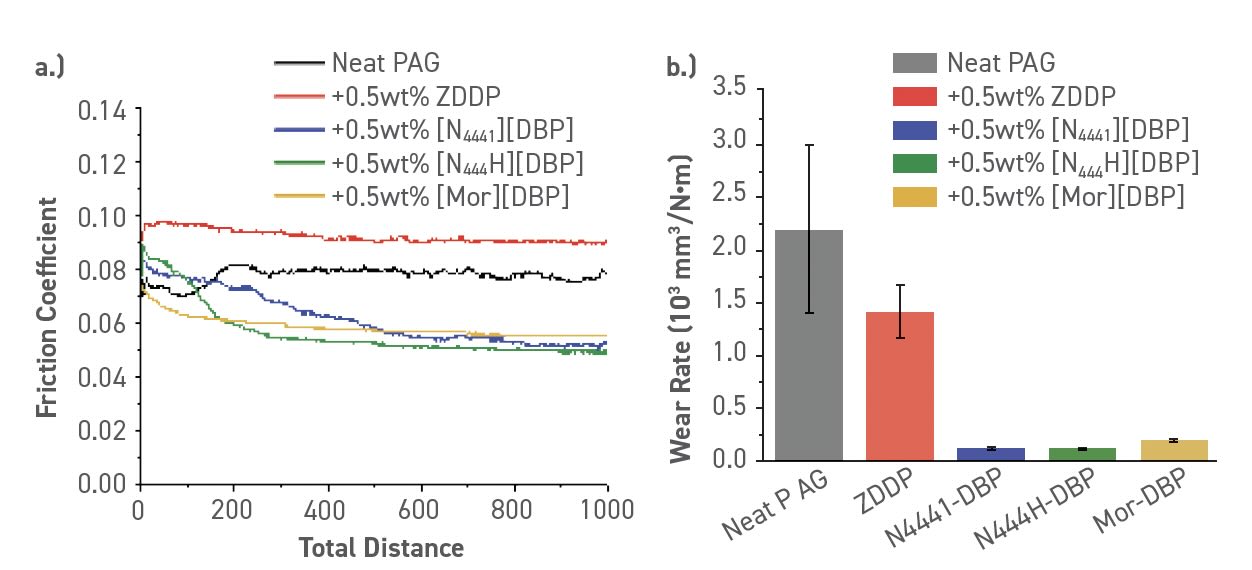 Figure 4. Selected tribological results: a.) Friction coefficients and b.) wear rates of neat PAG and PAG + 0.5% additive including ZDDP and three short-chain ILs. [MOR][DBP] is morpholinium dibutyl phthalate.14 Reprinted with permission from Xin He, Huimin Luo, Teresa J. Mathews, et al., ACS Sustainable Chemistry & Engineering. Copyright 2024, American Chemical Society.
Figure 4. Selected tribological results: a.) Friction coefficients and b.) wear rates of neat PAG and PAG + 0.5% additive including ZDDP and three short-chain ILs. [MOR][DBP] is morpholinium dibutyl phthalate.14 Reprinted with permission from Xin He, Huimin Luo, Teresa J. Mathews, et al., ACS Sustainable Chemistry & Engineering. Copyright 2024, American Chemical Society.
More importantly, an EPA-standard chronic aquatic toxicity test showed that all four short-chain ILs have significantly lower toxicity than the commercial products
(see Figure 5). The test uses the sensitive model organisms
Ceriodaphnia dubia and
Americamysis bahia, two types of water flea. When the fleas were exposed to the ILs, 70%-100% survived after 7 days, compared to none of the fleas surviving exposure to the bio-derived products, ZDDP or the eight-carbon ILs at the same concentration.
14,15
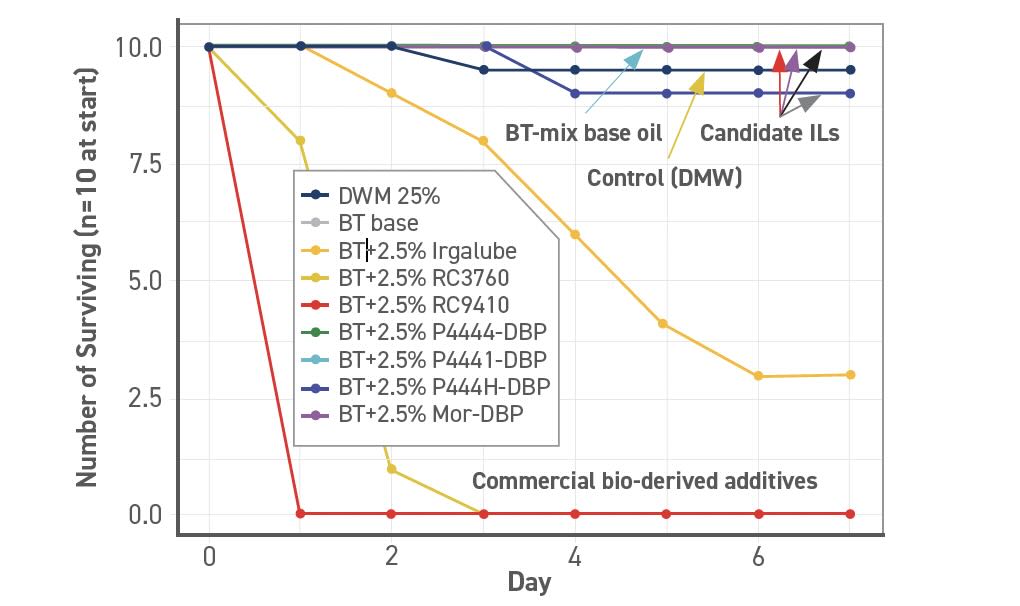 Figure 5. Aquatic toxicity tests show that ORNL’s new ionic liquids have much lower toxicity than commercial antiwear additives. The graph shows C. dubia survival when exposed to 200 ppm of a synthetic ester (BT) containing 2.5 wt% of ionic liquids or commercial products in water media. Figure courtesy of Ref. 15, CC BY.
Figure 5. Aquatic toxicity tests show that ORNL’s new ionic liquids have much lower toxicity than commercial antiwear additives. The graph shows C. dubia survival when exposed to 200 ppm of a synthetic ester (BT) containing 2.5 wt% of ionic liquids or commercial products in water media. Figure courtesy of Ref. 15, CC BY.
Further, Qu’s group’s latest results from a standard biodegradability test (OECD 301B) suggested that selected short-chain ILs, when added to a synthetic ester at 2% concentration, promoted the oil degradation from 60%-80% to 80%-100% in the 10-day window. In contrast, a commercial bio-derived additive at the same concentration reduced the oil degradation to below 50%, a downgrade from “readily” to “inherently” biodegradable.
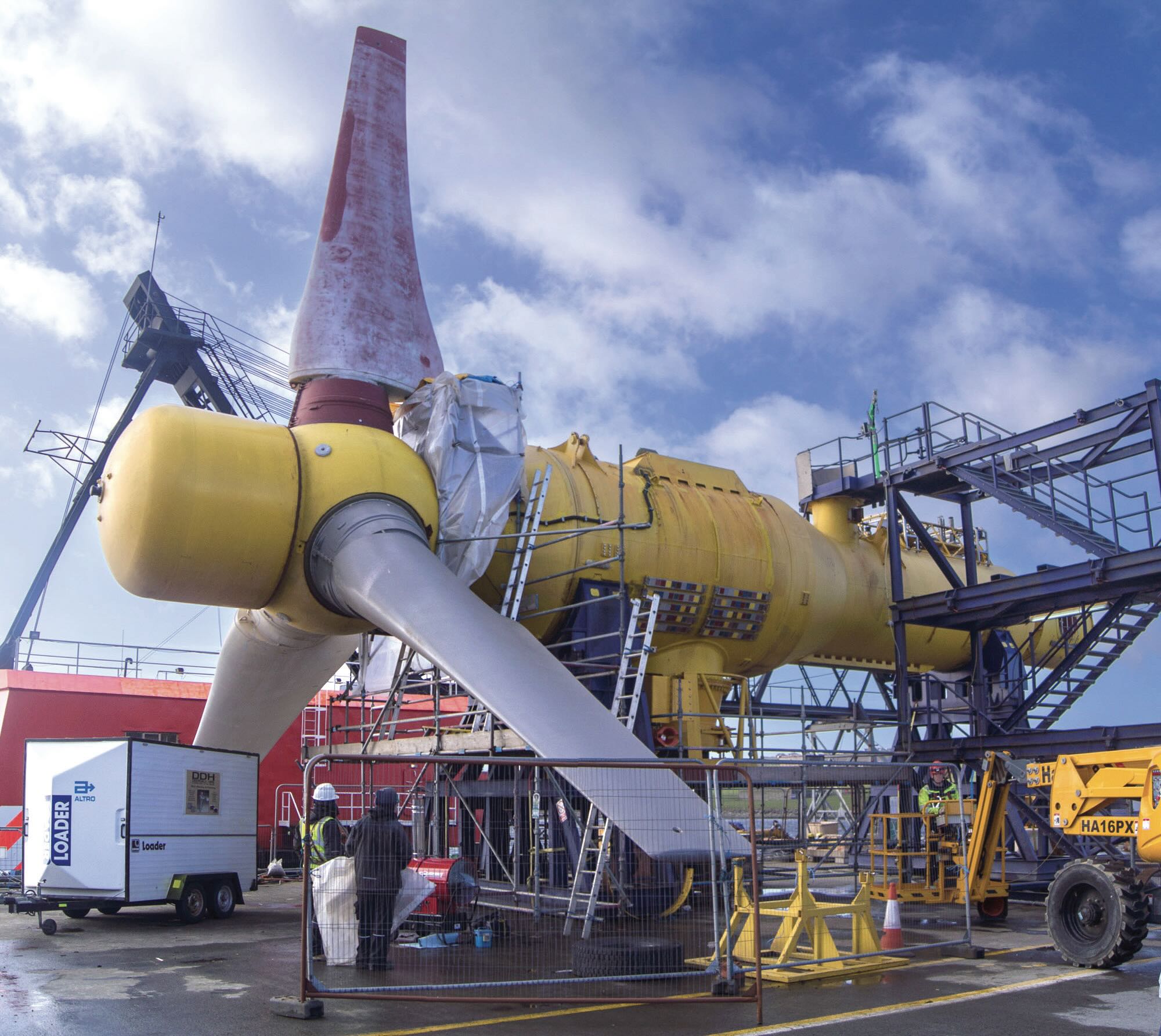 Photo courtesy of Drnoble/Wikimedia Commons, CC BY-SA 4.0.
Photo courtesy of Drnoble/Wikimedia Commons, CC BY-SA 4.0.
Keeping the rivers and oceans clean
This development is especially important for machinery that operates on or under water or near water sources. For example, hydroelectric and tidal turbines generate electrical energy from flowing water.
Conventional lubricating oils pose a significant threat to aquatic and marine ecosystems. They contain toxic components that would contaminate water directly in the event of a spill or leak, and they can form a film on the water’s surface that coats bird feathers and animal fur, damages fish gills and shellfish breathing mechanisms and poisons a wide variety of organisms, making food species unsafe for consumption.
Currently, tidal turbines use the same or similar lubricants as those used by wind turbines. However, tidal turbines operate at slower speeds and under greater forces because water is denser than air. Thus, tidal turbines do not form full-film lubrication, and they rely more highly on the antiwear additives in the lubricant. Further, the water environment can increase the moisture content of the lubricant, degrading its lubricity. Tidal turbines are more difficult to access than wind turbines, and maintenance intervals may be as long as six years, placing even higher demands on bearing and gear lubricants.
Antiwear additives have been less common in traditional hydroelectric turbine oils because the thrust and guide bearings ideally operate under hydrodynamic lubrication in steady-state operation. However, at starts and stops, the bearing interface inevitably falls into boundary lubrication, posing risks of bearing wear, which can be mitigated by antiwear agents. While historically hydroelectric turbomachines used to only start and stop once a day, they now are seeing multiple starts and stops daily to match the fluctuation of power needs, resulting in increasing needs of antiwear additives for wear protection.
ORNL’s new ILs have been shown to reduce friction and wear to half that of a baseline gear oil, which can improve energy conversion efficiency and enhance the durability and reliability of mechanical components. Further, the toxicity and biodegradability tests have demonstrated that EALs containing ILs, at the typical range of concentrations for antiwear additives (0.1%-2.5%), can be classified as “not toxic to aquatic and marine organisms” and “readily biodegradable.”
Questions remaining
New short-chain ILs from ORNL offer advantages in terms of performance and environmental protection and thus have great potential in EAL applications such as hydroelectric, hydraulics, water transport, agricultural machinery, automotive, offshore wind turbines and others.
ILs are being pursued mainly as additives for the time being because of their higher costs compared with conventional base oils. Qu notes that several fundamental questions remain to be answered with respect to using lubricants containing ILs.
Moving from a simple formulation containing a base oil and an IL to a fully formulated lubricant has proven to be a complex problem. Qu notes that not only does the direct compatibility between an IL and other additives in the package need to be addressed, but also that two-way compatibility does not always translate to three-way (or greater) compatibility.
How do IL-containing lubricant formulations age? Over a span of years, hydro or marine turbine oils will inevitably be contaminated with moisture. How does water contamination affect the lubricant’s performance? Qu’s group has been studying their formulations as fresh lubricants, but future studies will evaluate lubricant oxidation, decomposition and reaction with the surfaces of bearings and gears. They will use commercial baseline oils for comparison.
Although lubricant applications for ILs have only been around for about 25 years, they are emerging as strong contenders as lubricant additives because of their performance. Further, properly designed ILs can be more environmentally benign than conventional lubricant components. Promising applications include fluids for vehicle engine oils, industrial gear oils, waterpower turbine oils, hydraulic fluids, metalworking fluids and space lubricants. They could also serve as electrically conductive lubricants, liquid pistons, industrial coolants and fluids for micro- and nanoelectromechanical systems.
REFERENCES
1.
U.S. Environmental Protection Agency, Office of Wastewater Management (November 2011), “Environmentally acceptable lubricants,” EPA 800‐R‐11‐002.
2.
Geographic Scope And Forecast (December 2023), “Global environmentally acceptable lubricants market by type (mineral oils, fixed oils), by application (deep-sea, in-land/coastal),” Report ID: 633476. Available at www.verifiedmarketreports.com/product/environmentally-acceptable-lubricants-market/.
3.
Grand View Research, “Lubricants market size, share & trends analysis report by application (automotive, industrial, marine, aerospace), by base oil (mineral oil, synthetic oil, bio-based oil), by region, and segment forecasts, 2024 - 2030,” Report ID 978-1-68038-123-8. Available at:
www.grandviewresearch.com/industry-analysis/lubricants-market.
4.
Etkin, D.S. (2010), “Worldwide analysis of in-port vessel operational lubricant discharges and leakages,”
Proceedings of the 33rd AMOP Technical Seminar on Environmental Contamination and Response,
1, pp. 529-553.
5.
Zhou, Y. and Qu, J. (2017), “Ionic liquids as lubricant additives: A review,”
ACS Applied Materials & Interfaces,
9, pp. 3209-3222. Available at
https://doi.org/10.1021/acsami.6b12489.
6.
Qu, J. and Luo, H. M. (Oct. 8, 2019), “Ionic liquids containing symmetric quaternary phosphonium cations and phosphorus-containing anions, and their use as lubricant additives,” U.S. Patent 10,435,642.
7.
Qu, J., Luo, H. and He, X. (Sept. 19, 2023), “Ionic liquids containing quaternary ammonium and phosphonium cations, and their use as environmentally friendly lubricant additives,” U.S. Patent 11,760,766.
8.
Landauer, A. K., Barnhill, W. C. and Qu, J. (2016), “Correlating mechanical properties and anti-wear performance of tribofilms formed by ionic liquids, ZDDP and their combinations,”
Wear, 78, pp. 354-355,
https://doi.org/10.1016/j.wear.2016.03.003.
9.
Zhou, Y., Leonard, D. N., Guo, W. and Qu, J. (2017), “Understanding tribofilm formation mechanisms in ionic liquid lubrication,”
Scientific Reports, 7, article 8426,
https://doi.org/10.1038/s41598-017-09029-z.
10.
Barnhill, W. C., Gao, H., Kheireddin, B., Papke, B. L., Luo, H. M., West, B. H. and Qu, J. (2015), “Tribological bench and engine dynamometer tests of a low-viscosity SAE 0W-16 engine oil using a combination of ionic liquid and ZDDP as anti-wear additives,”
Frontiers in Mechanical Engineering – Engine and Automotive Engineering, 1, article 12.
11.
Kumara, C., Speed, L., Viola, M., Luo, H. M. and Qu, J. (2021), “Using ionic liquid additive to enhance lubricating performance for low-viscosity engine oil.”
ACS Sustainable Chemistry & Engineering, 9, pp. 7198-7205.
12.
Stump, B. C., Zhou, Y., Luo, H. M., Leonard, D. N., Viola, M. B. and Qu, J. (2019), “A new functionality of ionic liquids as lubricant additives: mitigating rolling contact fatigue,”
ACS Applied Materials & Interfaces, 11, pp. 30484-30492.
13.
Roy, S., Speed, L., Viola, M., Luo, H. M., Leonard, D. and Qu, J. (2021), “Oil miscible phosphonium-phosphate ionic liquid as novel anti-wear and anti-pitting additive for low-viscosity rear axle lubricants,”
Wear, 466-467, article 203588.
14.
He, X., Luo, H., et al. (2024), “Minimizing toxicity and optimizing lubricity of ionic liquids for eco-friendly lubrication,”
ACS Sustainable Chemistry & Engineering, 12, pp. 4344-4355. Available at
https://doi.org/10.1021/acssuschemeng.3c06194.
15.
He, X., Stevenson, L. M., et al. (2024), “Comparison of eco-friendly ionic liquids and commercial bio-derived lubricant additives in terms of tribological performance and aquatic toxicity,”
Molecules, 29, article 3851. Available at
https://doi.org/10.3390/molecules29163851.
Nancy McGuire is a freelance writer based in Albuquerque, N.M. You can contact her at nmcguire@wordchemist.com.